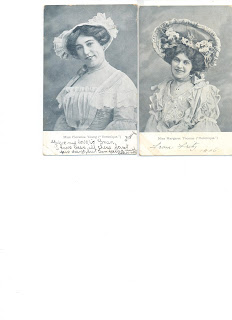1914 was a big year for juggling in Australia. Cinquevalli
toured and W C Fields returned. The year began with the arrival of a very
talented 'lady juggler' called Selma Braatz in January.
Selma arrived in 1913 aged 25 and was accompanied by Clara
and Fritz Braatz. Clara has been described variously as Selma's aunt or mother.
In Australia she was referred to as the juggler's mother, whilst Fritz was
referred to as her father.
The juggler was described as 'a young and trimly built lady
from Germany who juggled with any old thing in the way of light articles'. On
stage she wore a type of short suit, which was demure, but daring, in that it
revealed her legs.
Selma started her tour of Australia in January, in
Melbourne. It was pantomime season so her appearance at the Opera House in that
city was not much remarked upon . She toured the Tivoli in Sydney, where her
appearance was overshadowed by the newest dance craze, the Tango, and went to
provincial areas in Victoria such as Ballarat, where the open air nature of the
theatre interfered with her juggling. She also visited Perth and Kalgoorlie, a
mining town. Her itinerary, particularly the visits to the country areas,
suggested that she and her family were quite adventurous.
Her act consisted of balancing and juggling of unusual household
objects. Selma started her act juggling a tennis racquet, she then proceeded to
use a bell topper and stick and manipulated both to the audience's surprise and delight. She juggled billiard balls and balanced things on a cue stick. She
had difficulty with some of the balancing tricks in the open air Britannia Theatre
at Ballarat, but they were performed successfully in the bigger theatres of Melbourne,
Adelaide and Sydney.
The trick that won her the most applause was balancing a
tray, a wine glass, another tray, and an
egg on a billiard cue held upright on her chin. The trays were knocked away and
the egg fell into the wine glass without breaking.
As a finale, Selma juggled some carriage lamps. The house
lights were dimmed and as the lamps were thrown into the air they became
luminous, changing colour from white to red and on to violet.
Selma was assisted on stage by Clara who juggled soap bubbles.
Charles Waller described these as 'stiff bubbles, (which) may be blown either
from film cement or from a special soap solution, into the composition of which
enters a little gum arabic.' According to Waller, Selma was responsible for
introducing the juggling of soap bubbles into Australia.
Selma was apparently on good terms
with Cinquevalli, whose name always arose when jugglers were discussed in this
country. Apparently, they exchanged letters, and Cinq called Selma, 'Pauline',
a reference to his own name Paul.
Selma toured the whole country, and stayed for several
months, before returning overseas where she continued her juggling career.
She died in New York in 1973, reportedly aged 89.
SOURCES;
Arrival information about Clara, Fritz and Selma, from
Victorian Shipping records.
Description of Selma from The Adelaide Register, 4/03/1914
Description of Selma's act from The Adelaide Register.
4/03/1914,and The Argus (Melbourne)5/01/1914.
The description of soap bubble juggling comes from Magical
Nights in the Theatre by Charles Waller. Edited by Gerald Taylor.
The relationship between Selma and Cinquevalli is discussed in The Referee newspaper.11/2/1914
Pictures of Selma come from 1. The Australasian, 10/01/1914, 2. The World News, Sydney, 14/2/1914
Information about Selma's death comes from
juggle.org

















